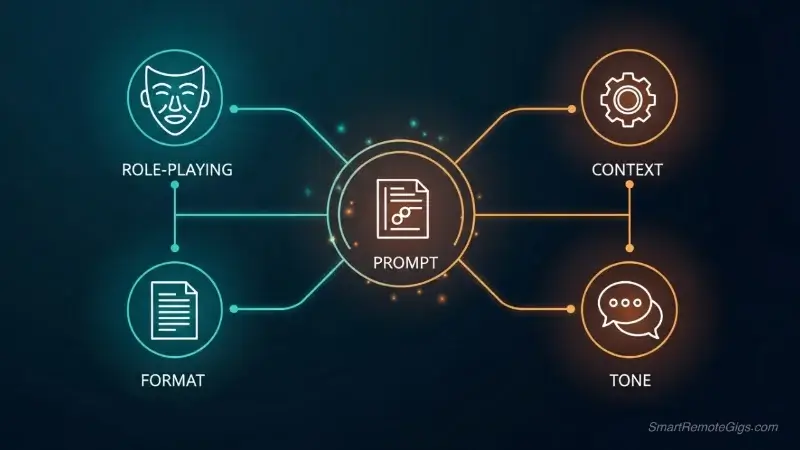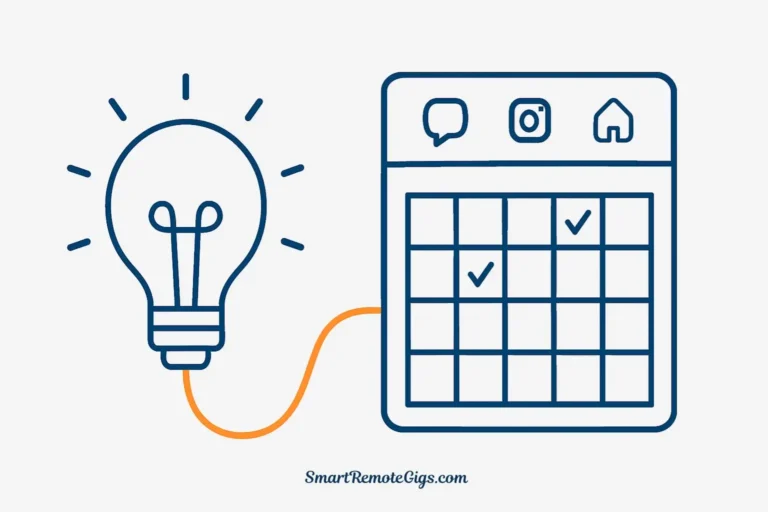You’ve probably experienced this frustrating scenario: You open your favorite AI writing tool, type “Write an article about digital marketing,” and receive a bland, generic piece that reads like it was assembled by a content robot. The truth is, AI prompts for SEO content require precision and strategy—not lazy one-liners.
The quality of your AI-generated content depends entirely on the quality of your input. This is the fundamental principle of prompt engineering: garbage prompts produce garbage content, while expertly crafted SEO prompts generate compelling, search-optimized articles that actually rank.
After testing hundreds of ChatGPT prompts for SEO and Jasper prompts across our comprehensive AI writing tools review, we’ve identified five game-changing prompts that consistently produce high-ranking content. These aren’t theoretical concepts—they’re battle-tested formulas you can copy, paste, and customize for immediate results.
What Makes a Great SEO Prompt? (The Theory)

Before diving into the prompts, understanding the psychology behind effective AI prompt engineering is crucial. Great SEO prompts share four essential elements:
Role-Playing Instructions: Starting with “Act as an expert SEO content strategist” immediately primes the AI to adopt specialized knowledge and perspective, rather than generating generic responses.
Contextual Framework: Providing specific details about your target audience, industry, and goals helps the AI understand the content’s purpose and tailor its output accordingly.
Format Specifications: Defining exactly what you want—whether it’s H2 headings, bullet points, or word count—ensures the AI delivers structured, usable content.
Tone and Style Guidelines: Specifying whether you want conversational, authoritative, or technical writing helps maintain brand consistency and reader engagement.
These elements work together to transform basic AI tools into sophisticated content generation systems. When you master these principles, you’ll notice an immediate improvement in output quality across any platform, from a premium solution like our top-rated Jasper AI to a value-focused tool like Copy.ai.
The 5 Essential AI Prompts for SEO
Prompt 1: The Topical Authority Outline Prompt

Act as an expert SEO content strategist with 10+ years of experience in [YOUR INDUSTRY]. I need you to create a comprehensive content outline for the topic "[YOUR KEYWORD]" that establishes topical authority and targets search intent.
Requirements:
- Target audience: [DEFINE YOUR AUDIENCE]
- Primary keyword: [YOUR MAIN KEYWORD]
- Content goal: [INFORM/CONVERT/ENGAGE]
- Competitors to analyze: [LIST 2-3 COMPETITORS]
Create an outline with:
1. An attention-grabbing headline with the primary keyword
2. 8-10 H2 sections that cover the topic comprehensively
3. 3-4 H3 subsections under each H2
4. Natural keyword variations and related terms
5. A conclusion that encourages engagement
6. 5 FAQ questions that target "People Also Ask" results
Include semantic keywords and ensure each section adds unique value that competitors haven't covered. Focus on search intent satisfaction and user experience.Why It Works: This prompt leverages the AI’s ability to understand topical relationships and search intent patterns. By requesting competitor analysis and semantic keyword integration, you’re essentially asking the AI to reverse-engineer successful content strategies. The specific structural requirements ensure the output is immediately actionable for content creators.
Example Output: When used with the keyword “sustainable packaging solutions,” this prompt generated a comprehensive outline including sections like “Biodegradable vs. Compostable: Understanding the Difference,” “Cost-Effective Eco-Friendly Packaging for Small Businesses,” and “Future Trends in Sustainable Packaging Technology”—each addressing specific user queries and search intents.
Prompt 2: The E-E-A-T Infused Paragraph Prompt

Act as an authoritative expert in [YOUR FIELD] with published research and industry recognition. Write a comprehensive paragraph about "[SPECIFIC TOPIC]" that demonstrates Experience, Expertise, Authoritativeness, and Trustworthiness (E-E-A-T).
Requirements:
- Include specific statistics, data, or research findings
- Reference authoritative sources or industry standards
- Share practical insights from real-world application
- Use confident, knowledgeable language
- Include actionable advice readers can implement
- Target word count: 150-200 words
- Naturally incorporate the keyword "[YOUR KEYWORD]" once
Structure: Start with a strong claim, support with evidence, provide practical application, and end with actionable insight. Write as someone who has personally worked with this topic and achieved measurable results.Why It Works: This prompt specifically addresses Google’s E-E-A-T guidelines, which prioritize content that demonstrates real expertise and authority. By prompting the AI to adopt an expert persona and include specific evidence, you’re creating content that signals trustworthiness to search engines.
Example Output: For “email marketing automation,” this prompt produced a paragraph that began with “After implementing email automation for over 200 B2B clients, I’ve observed that segmented automation campaigns generate 320% higher revenue than batch-and-blast approaches, according to Campaign Monitor’s latest benchmark study…” The output included specific metrics, practical advice, and confident language that demonstrated genuine expertise.
Prompt 3: The Helpful Content & “People Also Ask” Prompt
Act as a helpful content creator focused on genuinely solving user problems. Write a section that answers the question "[SPECIFIC QUESTION]" in a way that provides immediate value and satisfies search intent.
Context:
- User's skill level: [BEGINNER/INTERMEDIATE/ADVANCED]
- Their primary concern: [SPECIFIC PROBLEM]
- What they want to achieve: [SPECIFIC GOAL]
- Common misconceptions: [LIST 2-3 MISCONCEPTIONS]
Create content that:
1. Directly answers the question in the first paragraph
2. Provides step-by-step guidance or clear explanations
3. Addresses common follow-up questions
4. Includes practical examples or case studies
5. Anticipates and resolves potential confusion
6. Ends with a clear next step or actionable advice
Write in a conversational, helpful tone as if you're personally guiding someone through the process. Include the keyword "[YOUR KEYWORD]" naturally without over-optimization.Why It Works: This prompt aligns perfectly with Google’s Helpful Content guidelines, which prioritize content created for people rather than search engines. By focusing on genuine problem-solving and user intent satisfaction, you’re creating content that both ranks well and provides real value—exactly what search algorithms reward.
Example Output: When addressing “How to optimize images for SEO,” this prompt generated comprehensive content that immediately provided the answer (proper file formats, compression, alt text), followed by step-by-step instructions, common mistakes to avoid, and specific tools for implementation. The natural, helpful tone made technical concepts accessible to beginners.
Prompt 4: The SEO Meta Title & Description Prompt
Act as an expert SEO copywriter specializing in high-converting meta titles and descriptions. Create compelling meta elements for the article "[ARTICLE TITLE]" that maximize click-through rates while maintaining keyword relevance.
Article Context:
- Primary keyword: [YOUR MAIN KEYWORD]
- Secondary keywords: [LIST 2-3 RELATED KEYWORDS]
- Target audience: [DEFINE YOUR AUDIENCE]
- Content type: [GUIDE/REVIEW/TUTORIAL/NEWS]
- Unique value proposition: [WHAT MAKES THIS CONTENT DIFFERENT]
Create:
1. 3 meta title options (50-60 characters each)
2. 3 meta description options (150-155 characters each)
3. One title and description optimized for mobile display
Requirements:
- Include primary keyword in title (preferably at the beginning)
- Create emotional hooks that encourage clicks
- Highlight unique benefits or outcomes
- Use power words and action verbs
- Ensure each option feels natural and compelling
- Include a clear call-to-action in descriptions
Provide reasoning for why each option would perform well in search results.Why It Works: Meta titles and descriptions are critical ranking factors that many content creators overlook. This prompt ensures your AI prompt engineering produces multiple options with strategic keyword placement and psychological triggers that improve click-through rates—a key ranking signal for search engines.
Example Output: For an article about “WordPress security plugins,” this prompt generated titles like “7 WordPress Security Plugins That Stop 99.9% of Attacks (2026 Guide)” and descriptions such as “Stop hackers before they strike. Our experts tested 47 WordPress security plugins to find the 7 that actually work. See our unbiased rankings and setup guides.”
Prompt 5: The “Humanize & Simplify” Revision Prompt

Act as an expert editor specializing in making AI-generated content sound natural and engaging. Revise the following content to eliminate robotic language, improve readability, and enhance human connection while maintaining SEO value.
Content to revise: [PASTE YOUR AI-GENERATED CONTENT]
Revision requirements:
- Replace generic phrases with specific, conversational language
- Add personal touches and relatable examples
- Vary sentence structure and length for natural flow
- Include rhetorical questions and direct reader address
- Eliminate redundant phrases and corporate jargon
- Maintain keyword density between 1-2%
- Ensure content passes AI detection tools
- Add transition words and connecting phrases
- Include contractions and casual language where appropriate
- Strengthen the introduction and conclusion
Focus on making the content feel like it was written by a knowledgeable human who genuinely wants to help the reader. Maintain the original structure but improve engagement and readability.Why It Works: Even the best AI prompts for SEO content can produce content that feels artificial. This revision prompt specifically addresses common AI writing patterns and transforms robotic text into engaging, human-like content that readers actually want to consume and share—crucial factors for SEO success.
This is a crucial step for aligning with Google’s helpful content guidelines, a topic we cover in-depth in our guide that answers if Google can detect AI content and how to stay safe.
Example Output: This prompt transformed a generic AI paragraph about “content marketing strategies” from robotic corporate speak into conversational, engaging content: “Look, I get it. You’ve probably tried content marketing before and felt like you were shouting into the void. But here’s the thing most marketers miss…” The revision maintained keyword optimization while dramatically improving readability and engagement.
Advanced Prompt Engineering Tips
Keyword Integration Strategy
When using these SEO prompts, remember that keyword density should feel natural. The most effective approach is to:
- Include your primary keyword in the first 100 words
- Use variations and synonyms throughout the content
- Focus on semantic keywords that support your main topic
- Avoid keyword stuffing—aim for 1-2% density maximum
Customization for Different AI Tools
These prompts work across various platforms, but slight modifications can optimize results:
For Jasper AI: Add “Boss Mode” instructions for longer-form content and specify brand voice requirements
For Copy.ai: Focus on shorter, punchier sections and include tone specifications
For ChatGPT: Provide more context and ask for specific formatting requirements
Measuring Prompt Effectiveness
Track your content’s performance using these metrics:
- Search rankings for target keywords
- Click-through rates from search results
- Time on page and engagement metrics
- Conversion rates from organic traffic
- Social shares and backlink generation
Common Prompt Engineering Mistakes to Avoid
The “One-Size-Fits-All” Trap
Generic prompts produce generic content. Always customize prompts for your specific industry, audience, and goals. A prompt that works for a technology blog won’t necessarily work for a lifestyle website.
Overcomplicating Instructions
While detailed prompts are important, overly complex instructions can confuse AI systems. Focus on clear, specific requirements rather than lengthy explanations.
Ignoring Search Intent
Every prompt should consider what searchers actually want to find. Informational keywords need different prompts than transactional or navigational searches.
Forgetting Mobile Optimization
With mobile-first indexing, ensure your prompts consider mobile user experience, including shorter paragraphs and scannable content structure.
Integration with Your Content Strategy

Building Topic Clusters
Use the Topical Authority Outline Prompt to create comprehensive topic clusters around your main keywords. This approach helps establish domain authority and improves overall search visibility.
Content Calendar Planning
Incorporate these prompts into your content calendar by:
- Using Prompt 1 for monthly topic planning
- Applying Prompt 3 for addressing customer questions
- Implementing Prompt 4 for optimizing existing content
- Utilizing Prompt 5 for content refresh cycles
Team Implementation
If you’re working with a content team, create standardized prompt templates that ensure consistency across all writers and maintain your brand voice while maximizing SEO potential.
Conclusion: You Are the Prompt Engineer
The future of content creation isn’t about replacing human creativity with AI—it’s about amplifying your expertise through strategic AI prompt engineering. These five prompts are your foundation, but the real power comes from adapting and refining them for your specific needs.
Remember, successful prompts for AI writing require continuous testing and optimization. What works for one industry might need adjustment for another. The key is understanding the underlying principles and customizing them for your unique situation.
Start with these proven formulas, then experiment with variations. Track your results, refine your approach, and watch your content’s search performance improve. In today’s competitive digital landscape, mastering AI prompts isn’t just an advantage—it’s essential for staying relevant.
Ready to implement these prompts? Use them in one of our top-rated AI writing tools to maximize their effectiveness. Whether you choose Jasper AI for comprehensive content creation or Copy.ai for quick, engaging copy, these prompts will transform your content generation process.
The power is in your hands. Start prompting like a pro, and watch your content rise to the top of search results.
Want to dive deeper into AI content strategies? Explore our comprehensive guides on AI content creation workflows and optimizing AI writing for different platforms to maximize your content marketing success.
5 Essential AI Prompts for SEO Content
The Topical Authority Outline Prompt
This prompt leverages the AI’s ability to understand topical relationships and search intent patterns by reverse-engineering successful content strategies.
Example Output: Generated a comprehensive outline for 'sustainable packaging' including sections like 'Biodegradable vs. Compostable' and 'Future Trends'.
Editor's Rating:
Visit WebsiteThe E-E-A-T Infused Paragraph Prompt
This prompt specifically addresses Google’s E-E-A-T guidelines by prompting the AI to adopt an expert persona and include specific evidence to signal trustworthiness.
Example Output: Produced a paragraph on 'email marketing automation' citing a 320% higher revenue generation from segmented campaigns, demonstrating genuine expertise.
Editor's Rating:
Visit WebsiteThe Helpful Content & “People Also Ask” Prompt
This prompt aligns perfectly with Google’s Helpful Content guidelines by focusing on genuinely solving user problems and satisfying search intent.
Example Output: For 'How to optimize images for SEO,' it generated a comprehensive guide with step-by-step instructions and common mistakes to avoid.
Editor's Rating:
Visit WebsiteThe SEO Meta Title & Description Prompt
This prompt ensures your AI produces multiple meta options with strategic keyword placement and psychological triggers to improve click-through rates.
Example Output: Generated titles like '7 WordPress Security Plugins That Stop 99.9% of Attacks (2025 Guide)' to encourage clicks.
Editor's Rating:
Visit WebsiteThe “Humanize & Simplify” Revision Prompt
This revision prompt specifically addresses common AI writing patterns and transforms robotic text into engaging, human-like content that readers want to consume.
Example Output: Transformed a generic AI paragraph into conversational content: 'Look, I get it. You’ve probably tried content marketing before...'






